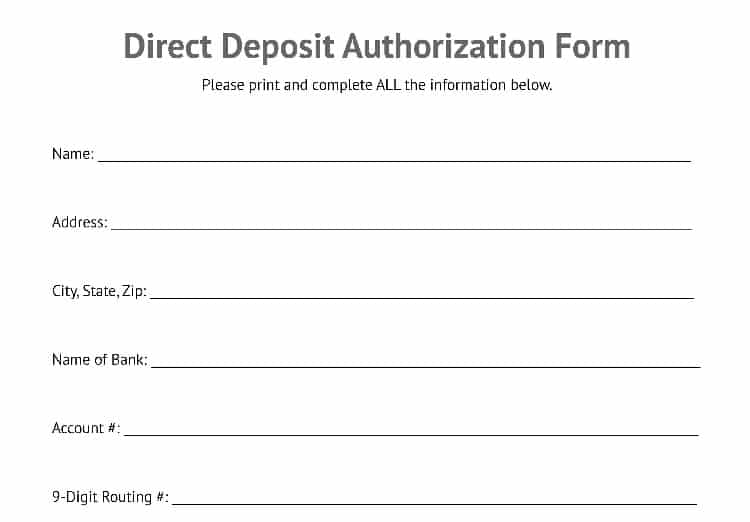Direct deposit is a secure electronic method of transferring funds from one bank account to another. In terms of payroll processing, employees receive their wages directly in their designated bank account instead of receiving a physical paycheck. This method of payment offers several advantages, including convenience, speed, and security.
The steps for setting up direct deposits are as follows:
Setting up direct deposit can be done through your bank or through a payroll provider. In either case, you’ll need to get signed authorization from your employees before pushing through with direct deposit payments. You can use our free direct deposit authorization form template for an easier time with this.
Step 1: Choose a Direct Deposit Provider
The two most common ways to set up direct deposit are through your bank and with your payroll software. Many payroll software offer this function and can automatically process payroll as direct deposits. There are also some HR services and software with payroll capabilities that can provide direct deposit services. If you are paying for payroll services, it makes sense to let them handle the direct deposit work.
For payroll software that can handle your direct deposit payments for you, we recommend Gusto. Employees can fill out their account and routing number, sign a direct deposit authorization during onboarding, and be ready to receive direct deposits right away. Learn more about it in our Gusto review.
No matter which option you choose, your bank is the one that transfers the funds. Thus, if you don’t work with your bank directly, you will need to share your bank account information with the software or service provider to have direct deposits set up.
If you’re looking to open a new account, check out our comparison of the best options:
Product | Monthly Fee | Free Monthly Transactions | APY | Free Cash Deposit Limit | Learn More |
 Silver Business Checking | None | 125 | N/A | $2,500 per month | |
Business Complete Banking | $15; waivable | 20 | N/A | $5,000 per month | |
Business Checking | None | No limit | 2.0% on qualifying balances of $250,000 or less | $4.95 per deposit (Green Dot) | |
 Fundamentals Business Checking | $16; waivable | 200 | N/A | $7,500 per month | |
 Relay Standard | None | None | N/A | No fee; Accepted at Allpoint ATMs | |
 Business Checking | None | No limit | N/A | No fee; cash deposited through money orders | |
 Basic Business Checking | $15; waivable | No limit | N/A | $5,000 per month | |
 Innovator Business Checking | None | No limit | Up to 2.25% | Cash deposits not accepted | |
 Business Checking | None | No limit | N/A | Cash deposits not accepted | |
Business Checking | None | No limit | N/A | Accepted at certain retail locations for a fee |
Learn more about these banks and what they can offer in our roundup of the best small business checking accounts.
Direct Deposit Costs
Banks usually charge a setup fee of up to $150. Some will charge monthly or transaction fees, which typically can run from $1.50 to $1.90 per individual transaction.
Step 2: Set Up Direct Deposit Service
Once you’ve decided on your direct deposit service, it should tell you the steps you need to take to set up your direct deposit. Remember that it can take a few days to a week to have everything in place. It’s important to set realistic expectations with your team so your employees don’t expect direct deposit with their next paycheck if it’s not yet possible.
Click the tabs below to learn the specifics of setting up direct deposits through your bank or with a payroll service provider:
Step 3: Get Employee Authorization & Bank Information
Although direct deposit is the most common way to pay your employees, your workers still must choose to be paid via direct deposit. Many states have their own regulations about how employees can be paid and whether or not you can mandate electronic payments for your team.
For more detailed information on your state’s mandates around direct deposits, check out our state payroll directory for easy access to all of our state payroll guides.
You will need signed consent to access your employee’s bank account information. We recommend you download our direct deposit authorization form template that you can distribute to all employees to help collect their information more easily.
You’ll also need to collect some other information from your employees to have direct deposits set up properly. You likely will need the following information:
- Bank routing number
- Bank account number
- Bank account type (checking/savings)
- Bank name
- Social Security number
- Employee name and address on the account (for verification to avoid mix-ups in delivery)
Pro Tip: If you have an HR or payroll software with an employee portal, you can have your employees fill out the information through the portal. However, make sure that as the employer, you have full access to this information, as some services will mask sensitive information, such as bank account numbers and Social Security numbers (ex. **** *** **038).
Step 4: Determine Pay Cycle
When having your direct deposits set up, it’s important to determine a regular pay period that works best for your company and employees to make sure that your payroll process runs smoothly. To help make that decision, consider the following:
- Determine required lead time: Consider the lead time that your bank or payroll service needs to complete the deposit after you process payroll. Also, decide whether it needs a longer lead time for holidays or weekends.
- In general, you need to log payroll two to four days before the day your employees get their checks. Some businesses will move that back when payday falls on a weekend or holiday to get deposits out the business day before.
- Determine your own financial schedule: Funds must be available to transfer into your business account before paychecks can be distributed, so be sure your schedule works with anticipated cash flow.
- Determine payday frequency: The most common pay periods are monthly, semimonthly (15th and 30th/31st), or biweekly. Biweekly employees usually get 26 paychecks a year at a slightly smaller amount; semimonthly get 24 paychecks at a slightly higher amount.
- Set deadlines with employees for submitting hours or time cards: Give yourself enough time to review the data and submit the processed payroll for direct deposit.
- Inform employees of the paydays: Generally, funds are available by 9 a.m. local time at the receiving depository institution, but it’s not set in stone; employees should expect funds by midnight of payday.
Your first pay run can take longer than usual, so allow extra time for setup to complete. It’s a good idea to run a test pay run of only a penny or other token amount. Ask employees to be on the lookout for this and to let you know if they have not received it by a specific date so you can track down any errors.
Direct deposits offer several benefits for both individuals and businesses. Here are some of the key advantages:
- Convenience and Speed: Direct deposits eliminate the need for physical checks, trips to the bank, or waiting for paper checks to arrive in the mail. Funds are automatically deposited into the recipient’s account on the scheduled date. Once the funds are sent, they are immediately available in the recipient’s account.
- Security: Direct deposits are considered a secure method of payment. They reduce the risk of lost or stolen checks, and the electronic transfer process is highly encrypted and protected. Electronic payments are also less susceptible to fraud compared to paper checks, as there is no physical document that can be altered or stolen.
- Reliability: With direct deposits, you can rely on a consistent and predictable payment schedule. This is especially important for employees who depend on regular paychecks and for businesses that need to ensure timely payments to suppliers and vendors.
- Cost Savings: Businesses can save money by reducing the costs associated with printing and mailing paper checks, as well as the expenses related to handling returned or lost checks.
- Automatic Bill Payments: Direct deposits make it easy for individuals to set up automatic bill payments, ensuring that recurring expenses, such as rent or mortgage payments, utility bills, and loan repayments, are made on time.
- Enhanced Record-Keeping: Direct deposits often come with detailed electronic records that make it easier to track and reconcile transactions. This can simplify financial management for both individuals and businesses.
- Improved Cash Flow Management: For businesses, direct deposits can improve cash flow predictability and management, as they can anticipate when funds will be received.
Understanding Direct Deposit Errors
One of the prime benefits of direct deposit is that it is generally timely and error-free, as long as you enter the correct payroll information. However, errors can occur. Here are some of the most common (though rare) problems that people experience with direct deposit and how to handle them.
Prevention is the best way to stop these errors. First, ask for a copy of a canceled check, so you can verify the account and bank routing numbers manually. Next, do a single test deposit of a penny to ensure the payment goes through correctly. Banks often catch errors and will either put the money into the correct account (sometimes with a delay) or refund it back to you.
If, despite all this, the employee claims they are not getting their paycheck, start by verifying you are sending to the account they’re checking (for example, if the employee gave you their savings account information instead of checking).
If somehow, the money does go to a legitimate but wrong account, you have five days to request a reversal. The payee must be notified, as outlined in the form instructions—but this is only a heads-up vs request for permission to transfer. You may first need to put a trace on the money to find where it has gone. In the meantime, you can cut your employee a paper check, put in an out-of-cycle payment to cover the paycheck, or have the employee work with their bank to credit them the money pending the actual deposit.
If you completed payroll on time, but your employees are saying they did not get their paychecks, you should first check that you actually did meet the correct deadline and allowed enough time for processing. Direct deposit can take two to four days to process—longer, if payday falls on a weekend or holiday.
If you have your dates correct, check that your account has sufficient funds to cover payroll. If that is not the problem, then call your bank or payroll service.
If your employee receives the wrong paycheck amount, check your payroll records. Were hours correctly calculated? Were all withholdings accounted for? Are the decimals in the right place?
Also, check that the employee did not ask for a split payment and if part of the balance was deposited to another account or is going to someone else for child support or other withholdings. You can correct errors by processing an additional transfer or check payment.
If you overpaid, you may be able to dock future paychecks, but be careful. Some state laws have strict rules about how you can retrieve overpayments (for instance, California); you still have to ensure the employee is receiving minimum wage.
Some banks don’t record deposits on holidays. Your best bet is to be prepared and run payroll early. The best employers plan so that deposits are made on Fridays if a payday falls on a weekend or bank holiday. That way, employees have their paychecks for the weekend.
This is usually due to human error in the payroll. Be sure to check that an employee is not listed twice and their payroll information is correct. You have five days for recalling the erroneous paycheck by putting in a Request for Reversal order. The reversal must be for the full amount, and the employee must be notified about the transaction.
National Automated Clearing House Association (NACHA) rules stipulate the entire amount must be refunded at once. Thus, if an employee’s account does not have enough funds to bankroll the reversal, then you will need to work with them on some other way to pay back the error.
Direct Deposit Frequently Asked Questions (FAQs)
Can I set up a direct deposit without a bank account?
Yes. The most common way to get a direct deposit without a bank account is by using a prepaid debit card. You can buy it at most major retailers. When you set up direct deposit, you will provide your employer with the card’s account number and routing number. Your paycheck will be deposited onto the card, and you can then use it to make purchases, withdraw cash, or transfer money to another account.
How long does a direct deposit take?
On average, a direct deposit takes two to four business days to clear. However, there are a few factors that can affect the processing time, such as the type of payment made, the time and day of the payment, and bank policies.
What do companies use for direct deposit?
Companies use a variety of methods for direct deposits, including banks, payroll providers, ACH networks, and mobile banking apps. The best method for a company to use for direct deposits will depend on a number of factors, such as the size of the company, the number of employees, and the company’s budget.
Bottom Line
Setting up your payroll with direct deposits for your employees can save your business some time and money. By sending paychecks directly to your employees’ accounts, you don’t have to deal with paper checks, and employees have access to their money right away. Although the process is generally seamless, errors are possible—so ensuring that the setup is done properly is crucial.
If you’d prefer to use payroll software that will set up and facilitate direct deposit for a small business, check out Gusto. Employees can authorize direct deposit payments during their onboarding process and Gusto will handle the rest. Try it today and get one month free when you run your first payroll. Offer will be applied to your Gusto invoice(s) while all applicable terms and conditions are met or fulfilled.
